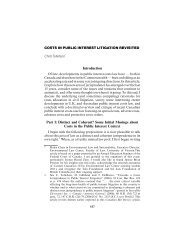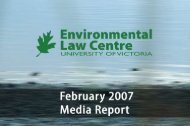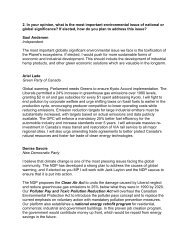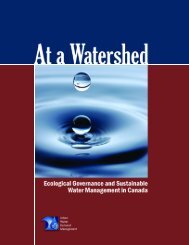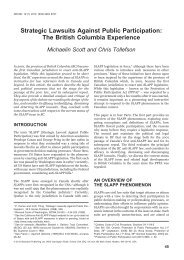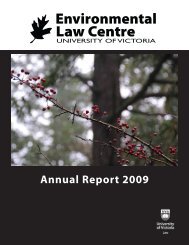Peeling back the Pavement - POLIS Water Sustainability Project
Peeling back the Pavement - POLIS Water Sustainability Project
Peeling back the Pavement - POLIS Water Sustainability Project
You also want an ePaper? Increase the reach of your titles
YUMPU automatically turns print PDFs into web optimized ePapers that Google loves.
PRoblem 2<br />
RAINWATER DOWN THE DRAIN: WASTE OF A VALUABLE<br />
RESOURCE<br />
In <strong>the</strong> Stormwater City, large amounts of money and resources are focused on<br />
drainage infrastructure because runoff (stormwater) is viewed as a threat that ultimately<br />
needs to be removed. However, transporting rainwater away from a property<br />
via storm drains when water is being piped to <strong>the</strong> very same property from a<br />
municipality’s centralized supply system translates into missed opportunities to use<br />
rainfall as a water source. In this era of strained infrastructure capacity, frequent<br />
water shortages, and growing environmental concern, why waste rainwater? Why<br />
not use it on site for non-drinking-water purposes?<br />
This missed opportunity<br />
comes at a great<br />
cost. Maintaining water<br />
supply infrastructure<br />
is expensive. In 2006,<br />
local governments in<br />
Canada spent over $4.5<br />
billion to purify and<br />
supply water—an expense<br />
compounded by<br />
growing demands that<br />
are, in part, fuelled<br />
by water overuse. 12<br />
Part of <strong>the</strong> problem is<br />
that <strong>the</strong>re really is no<br />
Photo: I Duke<br />
Low-density, automobile-dependent developments like this one<br />
in Markham, Ontario contribute to <strong>the</strong> billions of dollars Canadian<br />
municipalities must spend each year treating drinking water. Large<br />
amounts of impervious surfaces let rainwater run down <strong>the</strong> drain while,<br />
at <strong>the</strong> same time, water is piped <strong>back</strong> into homes for use.<br />
such thing as “drinking water” in Canadian cities. All municipal water is treated to<br />
drinking quality standards, whe<strong>the</strong>r we flush it down <strong>the</strong> toilet, wash our cars with<br />
it, use it to water <strong>the</strong> lawn, or drink it. Yet only a small portion of <strong>the</strong> water treated<br />
to drinking standards is actually used for purposes that require such high quality.<br />
According to Environment Canada, drinking, cooking, and bathing account for only<br />
about one-third of indoor residential water use.<br />
Our current water systems do not match water quality requirements to end use.<br />
Instead, as more water is piped through <strong>the</strong> supply infrastructure to satisfy growing<br />
demands, more water must be withdrawn from <strong>the</strong> source and treated to<br />
(costly) drinking standards. Viewing rainfall as a threat that needs to be quickly<br />
removed means that communities miss <strong>the</strong> opportunity to capture and store<br />
rainfall for reuse and reduce <strong>the</strong>ir dependence on centralized supply. This depletes<br />
local water supplies, undermines water conservation efforts, and eventually<br />
leads to demand for expensive new dams, bigger pumps, and increased water<br />
supply infrastructure.<br />
11



